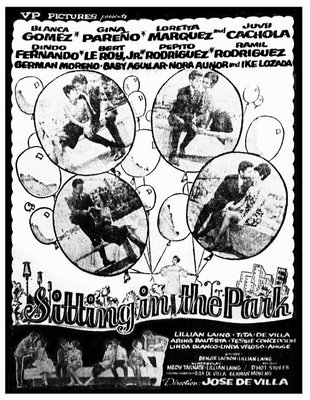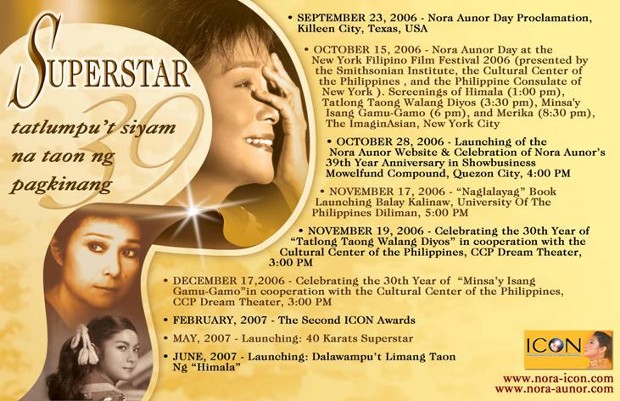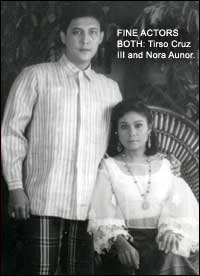

a blog and Super Collections for all Classic Tagalog Movies and Actors from 1912 to 2016 from famous and not so famous Movies in the Philippines, Actors and Actresses, Directors, Movie Company and Great Actors of Silent Films from Prewar up to the Present of Movie Video, Bluffs and other happenings and Award Giving Bodies.
Thursday, February 4, 2016
May Tampuhan Paminsan Minsan (1968) - Gina Pareno & Ricky Belmonte

Labels:
boy alano,
chichay,
german moreno,
gina pareno,
loretta marquez,
nora aunor,
ricky belmonte,
victor wood,
VP Pictures
 Born: March 23
Zodiac Sign: Aries
Chinese Sign: Dragon
Kinder: Proj 3, Kindergarten School
School: Proj 3., Elem. School
College: Feati University
P.S.B.A.
Movie Apperance: 150
Tv Appearances: 550
Contestant:
Lunch Date; Decoadin
Eat Bulaga: Music Maestro (11x Champion)
Born: March 23
Zodiac Sign: Aries
Chinese Sign: Dragon
Kinder: Proj 3, Kindergarten School
School: Proj 3., Elem. School
College: Feati University
P.S.B.A.
Movie Apperance: 150
Tv Appearances: 550
Contestant:
Lunch Date; Decoadin
Eat Bulaga: Music Maestro (11x Champion)
Bahay Kubo Kahit Munti (1968) - Rosemarie & Pepito Rodriguez

Labels:
Bahay Kubo Kahit Munti (1968) Rosemarie & Pepito Rodriguez,
blanca gomez,
edgar salcedo,
Pepito Rodrigiuez,
rosemarie,
sampaguita pictures
 Born: March 23
Zodiac Sign: Aries
Chinese Sign: Dragon
Kinder: Proj 3, Kindergarten School
School: Proj 3., Elem. School
College: Feati University
P.S.B.A.
Movie Apperance: 150
Tv Appearances: 550
Contestant:
Lunch Date; Decoadin
Eat Bulaga: Music Maestro (11x Champion)
Born: March 23
Zodiac Sign: Aries
Chinese Sign: Dragon
Kinder: Proj 3, Kindergarten School
School: Proj 3., Elem. School
College: Feati University
P.S.B.A.
Movie Apperance: 150
Tv Appearances: 550
Contestant:
Lunch Date; Decoadin
Eat Bulaga: Music Maestro (11x Champion)
Casiana de Leon
Labels:
CASIANA DE LEON
 Born: March 23
Zodiac Sign: Aries
Chinese Sign: Dragon
Kinder: Proj 3, Kindergarten School
School: Proj 3., Elem. School
College: Feati University
P.S.B.A.
Movie Apperance: 150
Tv Appearances: 550
Contestant:
Lunch Date; Decoadin
Eat Bulaga: Music Maestro (11x Champion)
Born: March 23
Zodiac Sign: Aries
Chinese Sign: Dragon
Kinder: Proj 3, Kindergarten School
School: Proj 3., Elem. School
College: Feati University
P.S.B.A.
Movie Apperance: 150
Tv Appearances: 550
Contestant:
Lunch Date; Decoadin
Eat Bulaga: Music Maestro (11x Champion)
Way Out in the Country (1967) - Vilma Valera & Bert Le Roy Jr

 Born: March 23
Zodiac Sign: Aries
Chinese Sign: Dragon
Kinder: Proj 3, Kindergarten School
School: Proj 3., Elem. School
College: Feati University
P.S.B.A.
Movie Apperance: 150
Tv Appearances: 550
Contestant:
Lunch Date; Decoadin
Eat Bulaga: Music Maestro (11x Champion)
Born: March 23
Zodiac Sign: Aries
Chinese Sign: Dragon
Kinder: Proj 3, Kindergarten School
School: Proj 3., Elem. School
College: Feati University
P.S.B.A.
Movie Apperance: 150
Tv Appearances: 550
Contestant:
Lunch Date; Decoadin
Eat Bulaga: Music Maestro (11x Champion)
Cinderella A-Go-Go (1967) - Rosemarie & Ricky Belmonte,

 Born: March 23
Zodiac Sign: Aries
Chinese Sign: Dragon
Kinder: Proj 3, Kindergarten School
School: Proj 3., Elem. School
College: Feati University
P.S.B.A.
Movie Apperance: 150
Tv Appearances: 550
Contestant:
Lunch Date; Decoadin
Eat Bulaga: Music Maestro (11x Champion)
Born: March 23
Zodiac Sign: Aries
Chinese Sign: Dragon
Kinder: Proj 3, Kindergarten School
School: Proj 3., Elem. School
College: Feati University
P.S.B.A.
Movie Apperance: 150
Tv Appearances: 550
Contestant:
Lunch Date; Decoadin
Eat Bulaga: Music Maestro (11x Champion)
Pogi (1967) - Eddie Gutierrez & Vilma Valera

Labels:
1967,
Marcelino Navarro (direction),
Pogi (1967) - Eddie Gutierrez & Vilma Valera,
sampaguita pictures
 Born: March 23
Zodiac Sign: Aries
Chinese Sign: Dragon
Kinder: Proj 3, Kindergarten School
School: Proj 3., Elem. School
College: Feati University
P.S.B.A.
Movie Apperance: 150
Tv Appearances: 550
Contestant:
Lunch Date; Decoadin
Eat Bulaga: Music Maestro (11x Champion)
Born: March 23
Zodiac Sign: Aries
Chinese Sign: Dragon
Kinder: Proj 3, Kindergarten School
School: Proj 3., Elem. School
College: Feati University
P.S.B.A.
Movie Apperance: 150
Tv Appearances: 550
Contestant:
Lunch Date; Decoadin
Eat Bulaga: Music Maestro (11x Champion)
Sitting in the Park (1967) - Blanca Gomez & Dindo Fernando

 Born: March 23
Zodiac Sign: Aries
Chinese Sign: Dragon
Kinder: Proj 3, Kindergarten School
School: Proj 3., Elem. School
College: Feati University
P.S.B.A.
Movie Apperance: 150
Tv Appearances: 550
Contestant:
Lunch Date; Decoadin
Eat Bulaga: Music Maestro (11x Champion)
Born: March 23
Zodiac Sign: Aries
Chinese Sign: Dragon
Kinder: Proj 3, Kindergarten School
School: Proj 3., Elem. School
College: Feati University
P.S.B.A.
Movie Apperance: 150
Tv Appearances: 550
Contestant:
Lunch Date; Decoadin
Eat Bulaga: Music Maestro (11x Champion)
Nora Aunor - 100 Women in the Philippines
100 Women of the Philippines
Celebrating Filipina Womanhood in the New Millennium
(Joy Buensalido & Abe Florendo, 1999)
NORA AUNOR by Gerard Ramos
In a society still governed by traditional concepts --- of gender roles, of family, of motherhood and so on --- Nora Aunor, actor would be an odd entry in a list of woman role models. Her marriage not only was short-lived but also has been dissolved. Her life has been marked with the most sordid of rumors, ranging from lesbianism to alcohol and substance abuse to neglect of her children.
And yet, notwithstanding all this, no such list would be complete without the entry “Nora Aunor” --- for simply being, well, Nora Aunor, the dark-skinned teenager from Iriga in the southern province of Bicol who went on to not only represent what is the finest in Filipino popular art but also embody the ideals and ideology of the nameless, faceless and voiceless in Philippine society.
That no other showbusiness life has been as much chronicled as hers, the story of Nora Aunor has assumed the status of myth over every wondrous retelling, and I believe, does need yet another retelling here but for the broadest strokes. About how the dusky “provinciana” went the circuitous path to astonishing, awesome fame from the dusty railroad tracks where she sold cold glasses of water to thirsty, disembarking passengers. In between this early attempt at enterprise and family chores, she joined local singing contests that ultimately brought her to Manila and on television as a finalist of “Tawag ng Tanghalan.” Not long after she was proclaimed champion --- for several months running --- of the national amateur singing competition, she made the foray into films singing with, alternately, dwarves and Tirso Cruz IIl.
The rest, as the cliché goes, is history.
It has been said, on occasion, that Nora Aunor achieved greatness in her art only late in her career, in the hands of such skilled film directors as Lino Brocka and Ishmael Bernal, as if the time frame should diminish one’s extraordinary accomplishments. And hers, indeed, have been exactly that, extraordinary --- unquestionably precious, and well before people had even heard of either Brocka or Bernal. As the National Artist Nick Joaquin himself once wrote, there was nothing mediocre about Nora Aunor even when she was singing with dwarves.
The voice, still heralded as golden for its clarity and timbre, is actually of limited range, scaling only up to two octaves at best. No matter, no other music artist has enthralled and continuous to enthrall an audience with a song as completely as Nora Aunor, whether she is doing a cover of Florante’s “Handog” of George or Ira Gershwin’s “Embraceable You.” There is an intelligence, a purity in her reading, in the way she tugs at a note or a phrase with the despair of many a lovelorn night. And, always, she is true to the spirit with which the song was written, always investing her soul to the emotional force of the musical ode. Thus, to say that her singing recalls the most venerable ladies in American music --- Billie Holiday, Judy Garland, Dinah Washington --- is not an exercise in hyperbole. The great American jazz artist Miles Davis once said, “Sometimes you can sing words every night for years, and all of a sudden it dawns on you what the song means.” Listening to Nora Aunor’s recordings is akin to this: an epiphanous moment that quickly becomes a shared experience of the breadth of human emotion.
Her genius as a music artist is, perhaps, surpassed only by her magnificence as an actor, which nobody saw as forthcoming --- surely, not even Nora Aunor herself --- given her early works. Mostly brainless popcorn musicals like “Blue Hawaii”, not a few maudlin melodramas like “Ang Munting Santa.” And yet, in hindsight, one could already see a glint of the promise now fulfilled even in as cheesy a melodrama as “Nasaan Ka, Inay” - in those almond-shaped eyes whose expressiveness has achieved the status of legend. They are eyes that have seen and not forgotten the hurt, the pain of not only material deprivation but the emotional variety as well --- a treasure trove for any actor.
And indeed, Nora Aunor has raided this trove on more than a few occasions, yielding extraordinary performances onstage --- in "DH" (Domestic Helper) and “Minsa’y Isang Gamu-gamo” --- and in films now regarded as modern classics in Philippine Cinema: “Tatlong Taong Walang Diyos,” “Minsa’y Isang Gamu-gamo,” “Atsay,” “Ina Ka ng Anak Mo,” “Bona,” “Bakit Bughaw ang Langit,” “Bulaklak ng City Jail,” “Ang Totoong Buhay ni Pacita M.,” and “Andrea…Paano Ba ang Maging Isang Ina?,” to name only a few. Surely, it is no small measure of her astonishing skills as an actor that while some of these films have dated --- to wit, “Minsa’y Isang Gamu-gamo” --- her performances have remained absorbing, incendiary.
In this exhilarating body of work which remains unsurpassed by any Filipino actor, bar none, the one that is perhaps the most definitive of her genius is her awesome turn in Ishmael Bernal’s “Himala,” a bleak, rancid portrait of our collective psychosis of religious and political fanaticism. As the faith healer Elsa, Nora gives a performance so daring in the ambiguity of her character strokes: by turns unprepossessing, self-possessed, guileless, scheming, imploring, contemptuous --- as if challenging us to reject her, all the while unshakable in her confidence that we cannot. In her performance alone, Bernal brings home his indictment of our penchant for fanatical worship.
In one of the few conversations I had with Bernal before his death in 1997, he confirmed that Nora was heavily favored to win as Best Actress at the Berlin International Film festival in 1982, when “Himala” was among the competing entries, and that she lost voting favor due to her absence at the festivities. Most people, disheartened, that it was a once-in-a-lifetime opportunity forever lost --- but, really, could this ever be the case with an artist as brilliantly as Nora Aunor? More than a decade later, in 1995, she scored yet another feat by winning the Best Actress for the powerful “the Flor Contemplacion Story” at the Cairo International Film Festival.
It has been assumed that, being unschooled formally as an actor, Nora Aunor has gotten by on sheer intuition and pure luck. The irony in this observation is that some film critics have, at one time or another, cited her as being too intelligent to play this role or that role --- for example, the naïve, subservient title character in Brocka’s acclaimed “Bona,” the original copy of which is in the hands of the French, from which the actor, who also produced the film, is working various channels to reclaim. But I digress. That Nora is an actor who trusts her gut is true, as it is for all other great actors, but she is fully cognizant and appreciative of the craft involved in creating great drama.
Indeed, through much of the filming of the award-winning Bakit May Kahapon Pa>, a riveting drama about the ravages of Martial Law's dirty war in the countryside, I witnessed a peerless craftsman at work: confining herself to her private room on the set, script in hand, her focus unyielding, oblivious of the few people that were allowed into her sanctuary. Asked about her process of character creation, Nora will only give the barest of details, almost embarrassed to do so -- and it becomes immediately apparent that this is not some affectation of humility but, quite simply, because of her innate understanding that, along with the craft, there is magic and mystery in the creation that should remain inviolable.
Of course, not everybody is a believer, and recently Nora Aunor has seen herself attacked for her latest performances that were supposedly too mannered, too studied to the point of remoteness, almost routine and therefore ordinary. One tabloid entertainment writer even went so far as to dismiss her portrayal of the speech-impaired Anna in last year's absorbing Sidhi as being bereft of either craft or magic -- but at the same time failed to provide an argument, even one remotely resembling, to shore up his attack.
Are Nora Aunor's feathers still ruffled by such biting criticism of her work? While she would be inclined to publicly shrug this off as one of the hazards of being an actor, one can only imagine how it impacts on an artist's emotional psyche given the intimacy involved in the process of character creation, the repeated rape to which the craft submits the heart and mind.
The dispassionate observer, however, is perhaps no longer surprised by such unqualified disparagement, which is often more telling of human foibles than the object of the attack herself. Indeed, one need only to remember the callous dismissal of Meryl Streep's post-Sophie Choice performances (Out of Africa in 1985, Heartburn in 1986, A Cry in the Dark in 1988, Postcards from the Edge in 1990, The House of the Spirits in 1993) as being cold and calculated, only to have film critics lavishing praiser on her similarly unquestionably and resolutely studied portrayals of the forlorn Italian-born Iowa housewife in 1995's The Bridges of Madison County. Go figure. History, as it often is, turns out to be the better judge. Consider how all the film award-giving bodies routinely ignored Himala, and how Bernal's masterpiece is now universally regarded as the finest film of that decade, and this particular Nora Aunor performance as the most galvanizing ever recorded on film.
An artist “assoluta” indeed Nora Aunor is. And in the current landscape of an acting community all too eager to sink to commercial vulgarity for the sake of box-office bankability, her resolute refusal to take easy routes, even at the expense of her celebrity, is worthy of the highest admiration. “I’ve reached point when it doesn’t matter whether I make one film in a year as long as it’s a good project and it says something about the human condition,” she says. “Otherwise, I’d rather go back to theater.”
No doubt to the chagrin of her critics, Nora Aunor has become the standard by which great performances are measured -- and, given the dearth of her heir apparents, will remain so for so many years. even at this period of her career that is blighted, they say, by dissipation and eroding celebrity, Nora Aunor has become the standard by which great performances are measured, and given, the dearth of heir apparents, will remain so for many years.
To the masses that have worshipped her through decades, however, Nora Aunor will forever remain emblematic of not only their dreams but also their possibilities. From the muddy railroad tracks of Iriga she had risen to triumph in aworld painfully indicative of our colonial history--and triumph, indeed, in a fashion never seen before or since. In doing so, she jolted us, perhaps more than any political figure in the last century, from a decades-long inferiority over the skin which we were born. Nora's unprecedented achievements since her rise to the nosebleed heights of celebrity stardom have only reinforced our potential for greatness.
Even in this period of diminished celebrity, as her critics like to call it, the brown-skinned former water vendor turned Superstar continues to define the times in which we live, these days not so much through her professional choices bu in our regard for the same. In the same way that Nora Aunor represents the infinite possibilities before us people, she now also reflects, in our unfortunate reaction to her ever-questing artistry, the moral bankruptcy to which we seem inexorably headed.
For this, Nora Aunor, the finest artist in Philippine entertainment, cannot be regarded simply as a role model. She is a woman continually essential --- to our dreams, to our conscience.
Labels:
nora aunor
 Born: March 23
Zodiac Sign: Aries
Chinese Sign: Dragon
Kinder: Proj 3, Kindergarten School
School: Proj 3., Elem. School
College: Feati University
P.S.B.A.
Movie Apperance: 150
Tv Appearances: 550
Contestant:
Lunch Date; Decoadin
Eat Bulaga: Music Maestro (11x Champion)
Born: March 23
Zodiac Sign: Aries
Chinese Sign: Dragon
Kinder: Proj 3, Kindergarten School
School: Proj 3., Elem. School
College: Feati University
P.S.B.A.
Movie Apperance: 150
Tv Appearances: 550
Contestant:
Lunch Date; Decoadin
Eat Bulaga: Music Maestro (11x Champion)
Superstar: Tatlumpu't Siyam na Taon ng Pagkinang

Labels:
nora aunor,
Superstar
 Born: March 23
Zodiac Sign: Aries
Chinese Sign: Dragon
Kinder: Proj 3, Kindergarten School
School: Proj 3., Elem. School
College: Feati University
P.S.B.A.
Movie Apperance: 150
Tv Appearances: 550
Contestant:
Lunch Date; Decoadin
Eat Bulaga: Music Maestro (11x Champion)
Born: March 23
Zodiac Sign: Aries
Chinese Sign: Dragon
Kinder: Proj 3, Kindergarten School
School: Proj 3., Elem. School
College: Feati University
P.S.B.A.
Movie Apperance: 150
Tv Appearances: 550
Contestant:
Lunch Date; Decoadin
Eat Bulaga: Music Maestro (11x Champion)
Superstar: Longest Running Musical Variety Show in the Philippines

Labels:
nora aunor,
Superstar
 Born: March 23
Zodiac Sign: Aries
Chinese Sign: Dragon
Kinder: Proj 3, Kindergarten School
School: Proj 3., Elem. School
College: Feati University
P.S.B.A.
Movie Apperance: 150
Tv Appearances: 550
Contestant:
Lunch Date; Decoadin
Eat Bulaga: Music Maestro (11x Champion)
Born: March 23
Zodiac Sign: Aries
Chinese Sign: Dragon
Kinder: Proj 3, Kindergarten School
School: Proj 3., Elem. School
College: Feati University
P.S.B.A.
Movie Apperance: 150
Tv Appearances: 550
Contestant:
Lunch Date; Decoadin
Eat Bulaga: Music Maestro (11x Champion)
Tirso Cruz III & Nora Aunor

Labels:
nora aunor,
tirso cruz iii
 Born: March 23
Zodiac Sign: Aries
Chinese Sign: Dragon
Kinder: Proj 3, Kindergarten School
School: Proj 3., Elem. School
College: Feati University
P.S.B.A.
Movie Apperance: 150
Tv Appearances: 550
Contestant:
Lunch Date; Decoadin
Eat Bulaga: Music Maestro (11x Champion)
Born: March 23
Zodiac Sign: Aries
Chinese Sign: Dragon
Kinder: Proj 3, Kindergarten School
School: Proj 3., Elem. School
College: Feati University
P.S.B.A.
Movie Apperance: 150
Tv Appearances: 550
Contestant:
Lunch Date; Decoadin
Eat Bulaga: Music Maestro (11x Champion)
Igorota Squad (1970) - Dante Varona & Rosanna Ortiz

 Born: March 23
Zodiac Sign: Aries
Chinese Sign: Dragon
Kinder: Proj 3, Kindergarten School
School: Proj 3., Elem. School
College: Feati University
P.S.B.A.
Movie Apperance: 150
Tv Appearances: 550
Contestant:
Lunch Date; Decoadin
Eat Bulaga: Music Maestro (11x Champion)
Born: March 23
Zodiac Sign: Aries
Chinese Sign: Dragon
Kinder: Proj 3, Kindergarten School
School: Proj 3., Elem. School
College: Feati University
P.S.B.A.
Movie Apperance: 150
Tv Appearances: 550
Contestant:
Lunch Date; Decoadin
Eat Bulaga: Music Maestro (11x Champion)
Igorota Squad - Dante varona & Rosanna Ortiz

 Born: March 23
Zodiac Sign: Aries
Chinese Sign: Dragon
Kinder: Proj 3, Kindergarten School
School: Proj 3., Elem. School
College: Feati University
P.S.B.A.
Movie Apperance: 150
Tv Appearances: 550
Contestant:
Lunch Date; Decoadin
Eat Bulaga: Music Maestro (11x Champion)
Born: March 23
Zodiac Sign: Aries
Chinese Sign: Dragon
Kinder: Proj 3, Kindergarten School
School: Proj 3., Elem. School
College: Feati University
P.S.B.A.
Movie Apperance: 150
Tv Appearances: 550
Contestant:
Lunch Date; Decoadin
Eat Bulaga: Music Maestro (11x Champion)
Bobby Velarde

Labels:
Bobby Velarde
 Born: March 23
Zodiac Sign: Aries
Chinese Sign: Dragon
Kinder: Proj 3, Kindergarten School
School: Proj 3., Elem. School
College: Feati University
P.S.B.A.
Movie Apperance: 150
Tv Appearances: 550
Contestant:
Lunch Date; Decoadin
Eat Bulaga: Music Maestro (11x Champion)
Born: March 23
Zodiac Sign: Aries
Chinese Sign: Dragon
Kinder: Proj 3, Kindergarten School
School: Proj 3., Elem. School
College: Feati University
P.S.B.A.
Movie Apperance: 150
Tv Appearances: 550
Contestant:
Lunch Date; Decoadin
Eat Bulaga: Music Maestro (11x Champion)
Bakya Mo Neneng (1977) Joseph Estrada, Nora Aunor & Tirso Cruz III
Labels:
JE Productions,
joseph estrada,
nora aunor,
tirso cruz iii
 Born: March 23
Zodiac Sign: Aries
Chinese Sign: Dragon
Kinder: Proj 3, Kindergarten School
School: Proj 3., Elem. School
College: Feati University
P.S.B.A.
Movie Apperance: 150
Tv Appearances: 550
Contestant:
Lunch Date; Decoadin
Eat Bulaga: Music Maestro (11x Champion)
Born: March 23
Zodiac Sign: Aries
Chinese Sign: Dragon
Kinder: Proj 3, Kindergarten School
School: Proj 3., Elem. School
College: Feati University
P.S.B.A.
Movie Apperance: 150
Tv Appearances: 550
Contestant:
Lunch Date; Decoadin
Eat Bulaga: Music Maestro (11x Champion)
Nasaan ka Inay (1970) - Nora AUnor & Tirso Cruz III (Sampaguita Pictures)
 Born: March 23
Zodiac Sign: Aries
Chinese Sign: Dragon
Kinder: Proj 3, Kindergarten School
School: Proj 3., Elem. School
College: Feati University
P.S.B.A.
Movie Apperance: 150
Tv Appearances: 550
Contestant:
Lunch Date; Decoadin
Eat Bulaga: Music Maestro (11x Champion)
Born: March 23
Zodiac Sign: Aries
Chinese Sign: Dragon
Kinder: Proj 3, Kindergarten School
School: Proj 3., Elem. School
College: Feati University
P.S.B.A.
Movie Apperance: 150
Tv Appearances: 550
Contestant:
Lunch Date; Decoadin
Eat Bulaga: Music Maestro (11x Champion)
Tierra Sangre (1970) - Fernando Poe Jr. & Liza Lorena
 Born: March 23
Zodiac Sign: Aries
Chinese Sign: Dragon
Kinder: Proj 3, Kindergarten School
School: Proj 3., Elem. School
College: Feati University
P.S.B.A.
Movie Apperance: 150
Tv Appearances: 550
Contestant:
Lunch Date; Decoadin
Eat Bulaga: Music Maestro (11x Champion)
Born: March 23
Zodiac Sign: Aries
Chinese Sign: Dragon
Kinder: Proj 3, Kindergarten School
School: Proj 3., Elem. School
College: Feati University
P.S.B.A.
Movie Apperance: 150
Tv Appearances: 550
Contestant:
Lunch Date; Decoadin
Eat Bulaga: Music Maestro (11x Champion)
Subscribe to:
Comments (Atom)

a.jpg)

